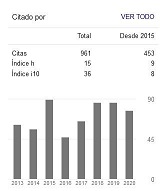Empleo de Saccharomyces cerevisiae para la prevención y control de las diarreas en terneros en pastoreo.
Resumen
Para evaluar el efecto probiótico de Saccharomyces cerevisiae en la prevención y control de las diarreas se selec-cionaron dos grupos homogéneos de terneros Siboney de Cuba (20 animales cada uno) con una edad aproximada de 180 días, en condiciones de pastoreo. Al grupo experimental se le dio caña molida ad libitum y 100 ml de cultivo líquido de Saccharomyces cerevisiae variedad C-40 (1,3 × 10 8 ufc/g) mezclado/kg de Norgold/animal; al control no se le suministró la levadura. En los cuatro meses de la evaluación se cuantificaron los episodios de diarrea y su duración, sin precisar la etiología. En los animales suplementados con el probiótico se produjeron ocho episodios de diarrea, de dos a tres días de duración promedio (total: 18 días). En el grupo control se produjeron 25 episodios, de tres a cinco días (total: 88 días). S. cerevisiae ejerce un efecto probiótico en terneros en pastoreo, contribuye a reducir la incidencia de diarreas y, cuando se produce, disminuye su duración.
Saccharomyces cerevisiae for Control and Prevention of Diarrhea in Grazing Calves.
ABSTRACT
Two homogenous Cuban Siboney groups (20 grazing animals each), approximately 180 days old were made up to assess the probiotic effect of Saccharomyces cerevisiaeon preventing and controlling diarrhea. The experimental group received sugar cane meal ad libitum,and 100 mlof liquid culture of Saccharomyces cerevisiae, variety C-40 (1.3 × 10 8 ufc/g), mixed/kg of Norgold/animal. No yeast was supplied to this group. During the four months of as-sessment the diarrhea episodes were produced from two to three days on average (18 days total). Twenty-five epi-sodes were observed in the control group, from three to five days (88 days total). S. cerevisiaehas a probiotic effect on grazing calves, helps reduce the incidence of diarrhea, and it lasts less when it occurs.
Descargas
Citas
ARRIBAS, MARÍA BELÉN (2009). Probióticos: una nueva estrategia de modulación de la respuesta inmune. Tesis de doctorado en Ciencias Farmacéuticas, Facultad de Farmacia, Universidad de Granada, España.
ARZUAGA, A. (2005). La cepa del yogur como probiótico, una alternativa en la salud y mejora del ternero. Revista Electrónica de Veterinaria REDVET, 6 (9). Extraído el 15 de agosto de 2013, desde http://www.veterinaria.org/revistas/redvet.
CORCIONIVOSCHI, N.; DRINCEANU, D.; STEF, L.; LUCA, I.; JULEAN, C. y MINGYART, O. (2010). Pro-biotics-Identification and Ways of Action. Innova-tive Romanian Food Biotechnology, 6, 1-11.
CORR, S. C. (2007). Bacteriocin Production as a Mechanism for the Antinfective Activity of Lactobacillus salivarius UCC118. Proc. Natl. Acad. Sci, 104, 7617-7621.
DELGADO, RÁNDOLPH (2014). Efecto probiótico de Saccharomyces cerevisiae en la ganancia de peso y salud de terneros en pastoreo. Tesis de Maestría en Producción Animal Sostenible, Facultad de Cien-cias Agropecuarias, Universidad de Camagüey, Cuba.
HOOPER, L . V.; LITTMAN, D. R. y MACPHERSON, A . J. (2012). Interactions between the Microbiota and the Immune System. Science, 336, 1268-1273.
JATKAUSKAS, J. y VROTNIAKIENE, V. (2010). Effects of Probiotic Dietary Supplementation on Diarrhoea Patterns, Faecal Microbiota and Performance of Early Weaned Calves. Veterinarni Medicina, 55, (10), 494-503.
JATKAUSKAS, J. y VROTNIAKIENE, V. (2014). Effects of Encapsulated Probiotic Enterococcus faecium Strain on Diarrhoea Patterns and Performance of Early Weaned Calves. Vet Med Zoot., 67, (89), 47-52.
LIÉVIN, V; PEIFFER, I .; HUDAULT, S.; ROCHAT, F.; BRASSART, D.; NEESER, J. R. et al. (2000). Bifidobacterium Strains from Resident Infant Human Gastrointestinal Microflora Exert Antimicrobial Activity. Gut., 47, 646-652.
MACHADO, I. B. (2002). Estadística aplica à experimentação animal. Minas Gerais, Brasil: FEPMVZ.
MEGANCK, V.; HOFLACK, G . y OPSOMER, G. (2014). Advances in Prevention and Therapy of Neonatal Dairy Calf Diarrhoea: a Systematical Review with Emphasis on Colostrum Management and Fluid Therapy. Acta Vet Scand., 56 (1), 75.
MORRISON, D. J.; MACKAY, W. G.; EDWARDS, C. A.; PRESTON, T.; DODSON, B. y WEAVER, L. T. (2006). Butyrate Production from Oligofructose Fermenta-tion by the Human Faecal Flora: What is The Con-tribution of Extracellular Acetate and Lactate? Br. J. Nutr., 96, 570-577.
SHIBA, T.; AIBA, Y.; I SHIKAWA, H.; USHIYAMA, A.; TAKAGI, A.; MINE, T. et al. (2003). The Suppressive Effect of Bifidobacteria on Bacteroides vulga-tus, a Putative Pathogenic Microbe in Inflammatory Bowel Disease. Microbiol Immunol, 47, 371-378.
WINDEYER, M. C.; LESLIE, K . E.; GODDEN, S. M.; HODGINS, D. C.; LISSEMORE, K. D. y LEBLANC, S. J. (2014). Factors Associated with Morbidity, Mortality, and Growth of Dairy Heifer Calves up to 3 Months of Age. Prev Vet Med., 113, 231-240.
Los autores de los artículos publicados en RPA retienen los derechos de autor de su trabajo, de marca y patente, y también sobre cualquier proceso o procedimiento descrito en el artículo, así como a compartir, copiar, distribuir, ejecutar y comunicar públicamente el artículo publicado en la RPA o cualquier parte de aquel siempre que indiquen la fuente de publicación (autores del trabajo, revista, volumen, número y fecha), pero están de acuerdo en que la revista publique los trabajos bajo una licencia Creative Commons.
![]() Licencia Attribution-NonCommercial 4.0 International (CC BY-NC 4.0)
Licencia Attribution-NonCommercial 4.0 International (CC BY-NC 4.0)






































